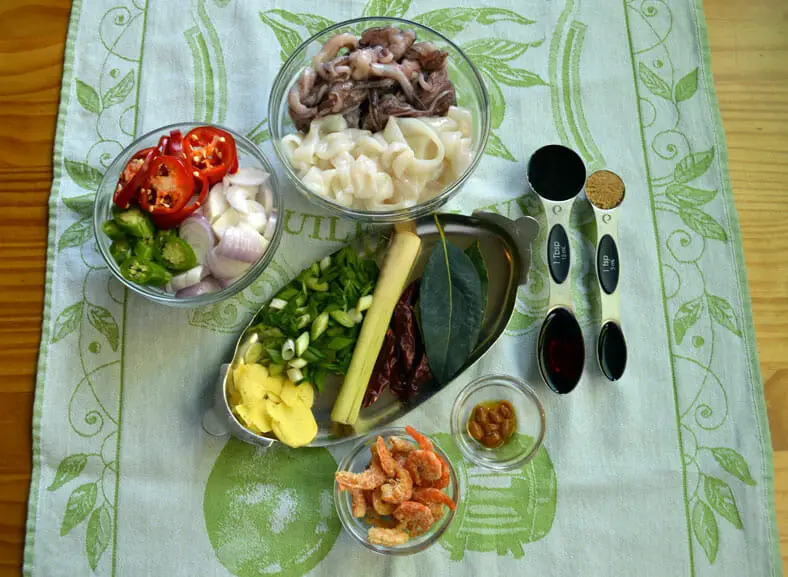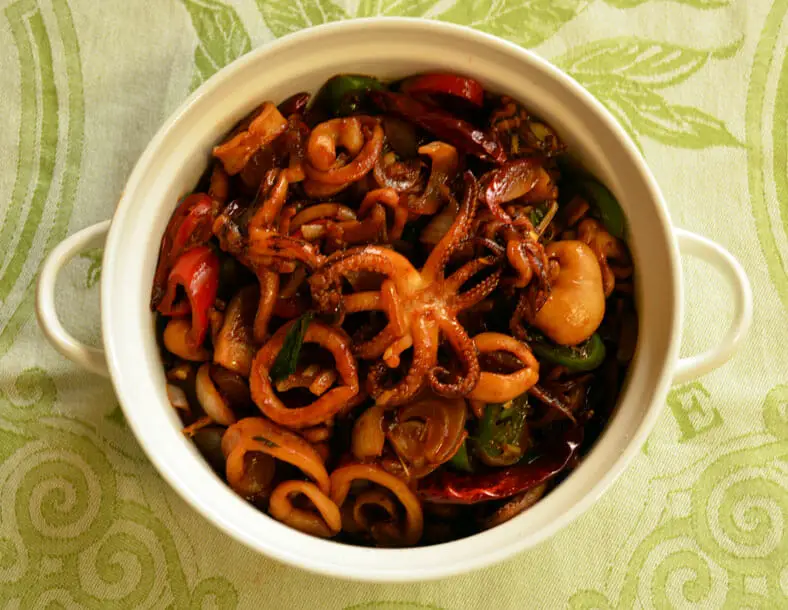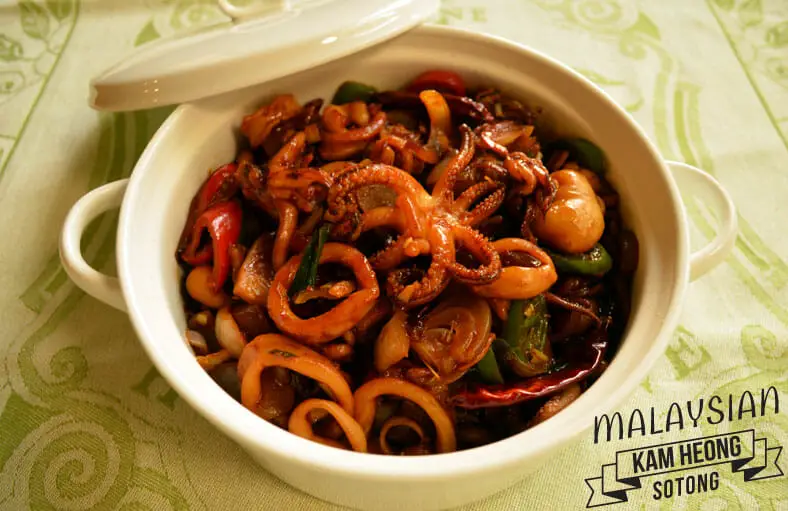How about that? We cooked our first fusion dish here on Arousing Appetites, and we didn’t even know it.
That’s exactly what kam heong is all about. While we used squid in our particular recipe, it’s not the ingredients that matter as much as the cooking style itself.

So What is Kam Heong?
Kam Heong is a Malaysian style of cooking that draws distinct influences from Chinese, Malay, and Indian cuisines. The name kam heong is actually a Cantonese phrase for “golden fragrance,” since one of the distinct qualities is the powerful aromas that immediately come from this style of cooking. It’s one of the more popular cooking methods you’ll find in the Malaysian cuisine.
There are several key ingredients to your traditional kam heong dish. For it to be truly authentic, you’re going to need pungent curry leaves, soy bean paste, dried shrimp (on Amazon), and – best of all – bird’s eye chilis. When cooked and heated together, you instantly get a whiff of a sweet yet salty, zesty yet wholesome aroma. Once you have the kam heong base set, you can add any type of protein you’d like, and it’ll come out extraordinarily well. We did find most kam heong recipes to be centered around seafood as the core protein in the dish, but it does seem like it could go just as well with, for example, chicken or tofu or anything else.
Note: For those that don’t like spicy as much, we would suggest scaling down any use of bird’s eye chilis in the recipe. They do bring massive character and flavor to the dish, but wow do they pack a powerful punch.
Adapting the Recipe
Technically, this kam heong recipe can be very healthy. However, what we’ve noticed as the greatest peril is using the wrong type of ingredients that might loaded with all sorts of unhealthy additives. Especially when it comes to ingredients for many East Asian cuisines, you need to be very vigilant that you’re getting as close to all-natural ingredients as you can.

Another thing that’s slightly less avoidable is that some ingredients are naturally higher in sodium than others. Soy sauce, for example, contains ~300mg of sodium per teaspoon, which is already one fifth of the ~1,500mg your body’s daily need. In order to counteract this “sodium charge,” we tried as best we can to scale back the proportions of sodium-rich ingredients as we could without compromising on the end taste. It actually took more than a few tests in order for us to get this really right, but we do think we’ve found the sweet and sour spot for a good balance.
For coating the squid, we swapped arrowroot powder instead of cornstarch, which we’ve found to be healthier and actually a better ingredient for creating a thick sauce coating both in this recipe and in Mapo Tofu. And using coconut oil as the oil base for the dish of course has its own nutritional perks. Our swapping of fish sauce (on Amazon) for oyster sauce in the original recipe, by the way, was more because we had fish sauce (on Amazon) more readily available.

Other than that, this dish is a cinch to make! It’s pretty much a linear process of adding ingredients once the kam heong base is cooking and fragrant. When using squid as your protein, you will want to stay vigilant so as not to overcook it, but really that just implies adding the sauce fairly soon thereafter… and taste testing frequently (and who doesn’t enjoy that?).

We hope you like it as much as we did. The next time around, we’ll try to cook with a kam heong dish with another type of protein, but we certainly love the way that squid came out in this cooking style!
Have you tried cooking kam heong before? Share your experiences with a comment below!


Kam Heong Sotong
- Total Time: 20 minutes
- Yield: 4 people 1x
Description
Kam Heong Sotong with chopped handful scallions.
Ingredients
-
- 1 lb of squid, cut into small ring pieces
- 2 tbsp arrowroot powder for squid marinade
- 2 tbsp of dried shrimps, first rehydrated then minced
- 3–4 curry leaves
- 1 stalk of Lemongrass, smashed
- 1 inch piece of ginger, shredded
- 5 dried chilis, rehydrated
- 3–4 birds eyes chilis sliced (if you want less spicy, choose 1–2 of a larger chili instead)
- 3 shallots, chopped
- 1 handful scallions, chopped
Sauce
-
- ½ tbsp Tau Cheong (salted soybean paste)
- 1 tbsp fish sauce (on Amazon)
- 1 tbsp Dark thick soy sauce
- 1 tsp Soy sauce
- 1 tsp Sugar
Instructions
Preparation
- Prior to cooking, coat the squid in the arrowroot powder
Stage 1: Pre-cook Squid
- Heat up a wok (or saucepan if no wok available) on highest possible heat
- Add ~3 tbsp of oil to the wok once it’s piping hot. We used coconut oil in our recipe but whichever oil you prefer here
- Add the arrowroot-coated squid to the wok and cook for just 1 minute, then remove from heat
Stage 2: Bringing it all together
- Wipe wok clean with a paper towel and add another 2 tbsp oil
- Start by adding the dried shrimps first and sauteeing until fragrant (roughly 1 min)
- Add your shallots, scallions, chilis, curry leaves, lemongrass, ginger. Toss all the ingredients around vigorously and continue to fry for 2 minutes together
- After several minutes, re-add the squid and toss around
- Add the sauce and water into the wok. However much water you add is totally up to you. If you want more sauce, then add more water, but add at least 2 tbsp to help spread the flavor of the sauce around the dish
- Take the wok off heat and serve immediately. Garnish with scallions
- Prep Time: 10 mins
- Cook Time: 10 mins
- Category: Entree
- Cuisine: Malaysian

